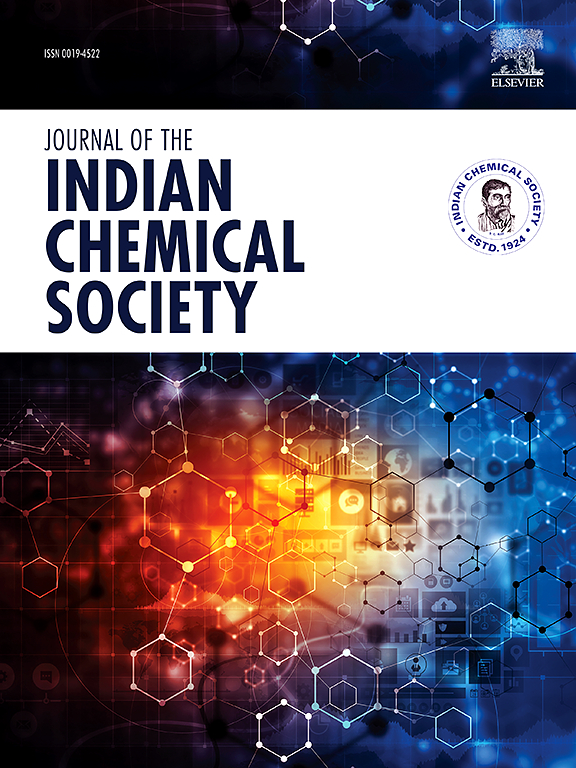生物活性分子普瑞巴林解锁对金簇的影响:溶剂化、SERS和反应性分析
IF 3.2
4区 化学
Q2 CHEMISTRY, MULTIDISCIPLINARY
引用次数: 0
摘要
本文研究了普瑞巴林((S)-3-(氨基乙基)-5-甲基己酸)(PGB)与不同位置的Au4簇的相互作用。吸附过程是放热的,这有利于药物输送应用。MEP分析表明,PGB通过OH (X1)、CO (X2)、NH2 (X3)和CH3 (X4)与Au4相互作用,真空吸附能为- 6.27/-26.06/-39.74/-4.21,水溶液吸附能为- 16.16/-35.36/-53.22/-15.49 kcal/mol。在PGB-Au4配合物中出现新的谱带是由于表面增强拉曼光谱(SERS)效应。对于吸附能最大的X2和X3构型,与Au4表现出强相互作用,吸附能大于−23.0 kcal/mol,可归类为化学吸附,而X1和X4的吸附能小于−23.0 kcal/mol,属于物理吸附。所有Au4-PGB体系的亲电性指数均大于PGB值,这表明金簇的加入使药物的亲电性增强。随着能量间隙的缩小,簇的导电性增加,使其适合用作药物传感器。溶剂具有较高的负溶剂化能,说明溶剂介质更稳定。相互作用分析证实了NCI的存在。ELF分析表明,Au4簇与PGB表面形成离子键。药物载体的活性从对接分数中可以看出。本文章由计算机程序翻译,如有差异,请以英文原文为准。
Unlocking on the effect of gold cluster with pregabalin, a bioactive molecule: Solvation, SERS and reactivity analysis
The interaction of pregabalin ((S)-3-(Aminoethyl)-5-methylhexanoic acid) (PGB) with Au4 clusters at various positions is studied computationally investigated and reported. Adsorption processes are exothermic which is beneficial for drug delivery applications. PGB is interacted with Au4 through its OH (X1), C![]() O (X2), NH2 (X3) and CH3 (X4) according to MEP analysis and the adsorption energies are, −6.27/-26.06/-39.74/-4.21 in vacuum and −16.16/-35.36/-53.22/-15.49 kcal/mol in aqueous medium. The appearance of new bands in PGB-Au4 complexes is due to surface enhanced Raman spectroscopy (SERS effect). For X2 and X3 configurations with maximal adsorption energies, strong interaction is shown with the Au4 and these adsorptions can be categorized as chemisorptions since adsorption energies are larger than −23.0 kcal/mol, while X1 and X4 have a physisorption adsorption process since adsorption energy is less than −23.0 kcal/mol. All Au4-PGB systems have electrophilicity indices greater than the PGB value, implying that adding of gold clusters makes pharmaceuticals more electrophilic. As the energy gaps close, the cluster's conductivity increases making it suitable for use as a drug sensor. Solvents have higher negative solvation energies, indicating that the solvent medium is more stable. The presence of NCI is confirmed using interaction analysis. ELF analysis reveals that Au4 cluster forms an ionic bond with the PGB surface. Drug carrier activity is evident from the docking scores.
O (X2), NH2 (X3) and CH3 (X4) according to MEP analysis and the adsorption energies are, −6.27/-26.06/-39.74/-4.21 in vacuum and −16.16/-35.36/-53.22/-15.49 kcal/mol in aqueous medium. The appearance of new bands in PGB-Au4 complexes is due to surface enhanced Raman spectroscopy (SERS effect). For X2 and X3 configurations with maximal adsorption energies, strong interaction is shown with the Au4 and these adsorptions can be categorized as chemisorptions since adsorption energies are larger than −23.0 kcal/mol, while X1 and X4 have a physisorption adsorption process since adsorption energy is less than −23.0 kcal/mol. All Au4-PGB systems have electrophilicity indices greater than the PGB value, implying that adding of gold clusters makes pharmaceuticals more electrophilic. As the energy gaps close, the cluster's conductivity increases making it suitable for use as a drug sensor. Solvents have higher negative solvation energies, indicating that the solvent medium is more stable. The presence of NCI is confirmed using interaction analysis. ELF analysis reveals that Au4 cluster forms an ionic bond with the PGB surface. Drug carrier activity is evident from the docking scores.
求助全文
通过发布文献求助,成功后即可免费获取论文全文。
去求助
来源期刊
CiteScore
3.50
自引率
7.70%
发文量
492
审稿时长
3-8 weeks
期刊介绍:
The Journal of the Indian Chemical Society publishes original, fundamental, theorical, experimental research work of highest quality in all areas of chemistry, biochemistry, medicinal chemistry, electrochemistry, agrochemistry, chemical engineering and technology, food chemistry, environmental chemistry, etc.

 求助内容:
求助内容: 应助结果提醒方式:
应助结果提醒方式:


